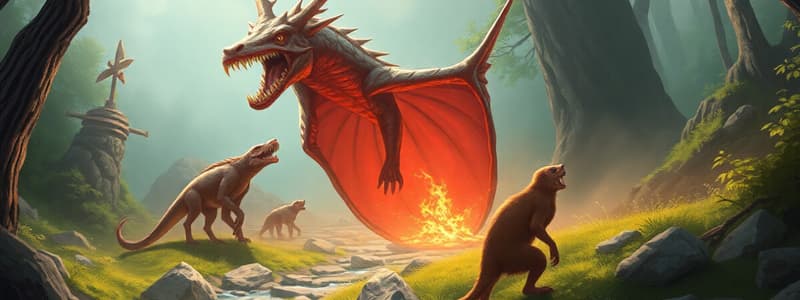Podcast
Questions and Answers
Adaptations are changes that help an organism ______ in its environment.
Adaptations are changes that help an organism ______ in its environment.
survive
A giraffe's long neck is a _____ adaptation that helps it reach high leaves.
A giraffe's long neck is a _____ adaptation that helps it reach high leaves.
physical
Birds migrating to warmer places during winter is a ______ adaptation.
Birds migrating to warmer places during winter is a ______ adaptation.
behavioral
Camels store water in their bodies as a ______ adaptation to survive in the desert.
Camels store water in their bodies as a ______ adaptation to survive in the desert.
Polar bears have white fur that helps them ______ into the snowy environment.
Polar bears have white fur that helps them ______ into the snowy environment.
Which of the following is a physical adaptation?
Which of the following is a physical adaptation?
What is the main reason an animal to have adaptations?
What is the main reason an animal to have adaptations?
Which of the following is an example of a behavioral adaptation?
Which of the following is an example of a behavioral adaptation?
Match the correct adaptation to the correct animal picture.
Match the correct adaptation to the correct animal picture.
Predators often have sharp teeth and claws to catch their prey.
Predators often have sharp teeth and claws to catch their prey.
Predators have dull eyesight and good hearing to spot their prey from a distance.
Predators have dull eyesight and good hearing to spot their prey from a distance.
Some predators, like the chameleon, can change color to blend in with their surroundings. This helps them sneak up on their prey without being seen.
Some predators, like the chameleon, can change color to blend in with their surroundings. This helps them sneak up on their prey without being seen.
Many prey animals are slow runners, like gazelles, which can quickly escape from predators.
Many prey animals are slow runners, like gazelles, which can quickly escape from predators.
Prey animals, such as rabbits, have strong hind legs to leap away quickly.
Prey animals, such as rabbits, have strong hind legs to leap away quickly.
Some animals, like certain species of frogs, are good at hiding and can blend into their environment, making it hard for predators to find them.
Some animals, like certain species of frogs, are good at hiding and can blend into their environment, making it hard for predators to find them.
Fish have fins and gills that help them swim and fight underwater.
Fish have fins and gills that help them swim and fight underwater.
Water lilies have thin leaves that float on the surface, allowing them to get sunlight.
Water lilies have thin leaves that float on the surface, allowing them to get sunlight.
Flashcards
Adaptation
Adaptation
A special feature or behavior that helps a living thing survive in its environment.
Physical Adaptation
Physical Adaptation
A change in an organism's body structure to help it survive.
Behavioral Adaptation
Behavioral Adaptation
A change in an organism's actions to help it survive.
Evolution
Evolution
Signup and view all the flashcards
Food adaptation
Food adaptation
Signup and view all the flashcards
Predator avoidance
Predator avoidance
Signup and view all the flashcards
Reproduction adaptation
Reproduction adaptation
Signup and view all the flashcards
Environmental adaptation
Environmental adaptation
Signup and view all the flashcards
Water storage (plants)
Water storage (plants)
Signup and view all the flashcards
Waxy coating (plants)
Waxy coating (plants)
Signup and view all the flashcards
Deep roots (plants)
Deep roots (plants)
Signup and view all the flashcards
Thick fur/blubber (animals)
Thick fur/blubber (animals)
Signup and view all the flashcards
Survival Adaptations
Survival Adaptations
Signup and view all the flashcards
Hot environment
Hot environment
Signup and view all the flashcards
Cactus
Cactus
Signup and view all the flashcards
Polar bear
Polar bear
Signup and view all the flashcards
Study Notes
Adaptations
- Adaptations are special features or behaviors that help living things survive in their environments.
- Adaptations allow organisms to live, grow, and thrive.
- These changes occur over time through evolution.
Types of Adaptations
- Physical Adaptations: Body structures that help an organism survive.
- Example: A giraffe's long neck allows it to reach high leaves.
- Behavioral Adaptations: Actions organisms take to survive.
- Example: Birds migrating to warmer places during winter.
- Physiological Adaptations: Internal processes that help an organism survive.
- Example: Camels storing water in their bodies.
Importance of Adaptations
- Adaptations are crucial for species survival.
- Finding Food: Adaptations help animals find and gather food.
- Escaping Predators: Adaptations help animals avoid being eaten.
- Reproduction: Adaptations aid in successful reproduction.
- Surviving Environmental Changes: Adaptations help species survive changing environments.
Examples of Adaptations
- Cacti: Thick waxy skin helping them retain water in desert environments.
- Polar Bears: White fur for blending into snowy environments.
- Chameleons: Ability to change color to match their surroundings.
- Frogs: Sticky pads on feet for climbing trees.
- Fish: Fins and tails for swimming quickly.
Plant Adaptations in Hot Environments
- Water Storage: Thick, fleshy stems to store water, like cacti.
- Waxy Coatings: Reduces water loss, like in succulents.
- Deep Roots: Reaching underground water sources, like mesquite trees.
Animal Adaptations in Cold Environments
- Thick Fur/Blubber: Keeping warm in frigid temperatures.
- Camouflage: Blending in with the environment, like Arctic foxes.
- Small, Waxy Leaves: Reducing water loss in cold environments.
Animal Adaptations in Wet Environments
- Wide, Flat Leaves: Collecting sunlight in wet environments.
- Special Roots: Breathing air, like mangrove trees.
- Smmoth, Moist Skin: Absorbing water, like frogs.
Adaptions of Predators and Prey
- Predators: Have sharp teeth/claws for catching prey, sometimes good eyesight/hearing.
- Prey: Adaptations to avoid being caught, like speed, camouflage, or hiding.
Studying That Suits You
Use AI to generate personalized quizzes and flashcards to suit your learning preferences.




